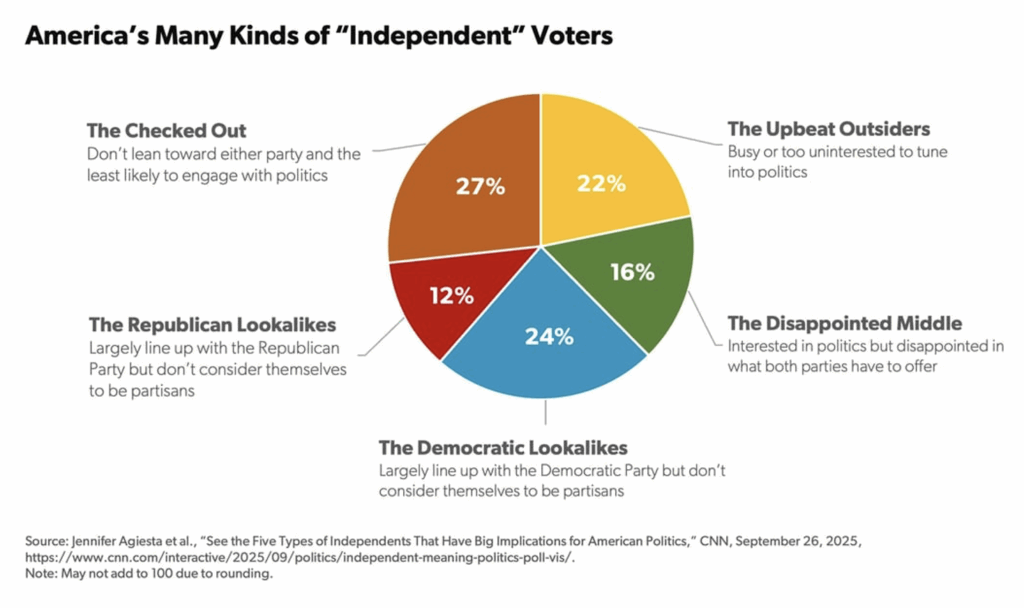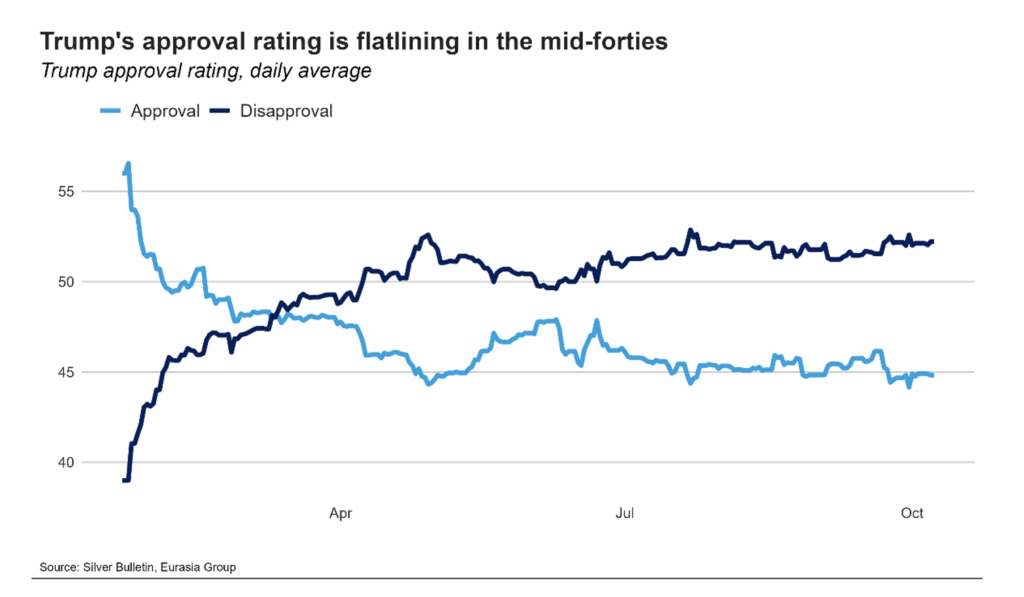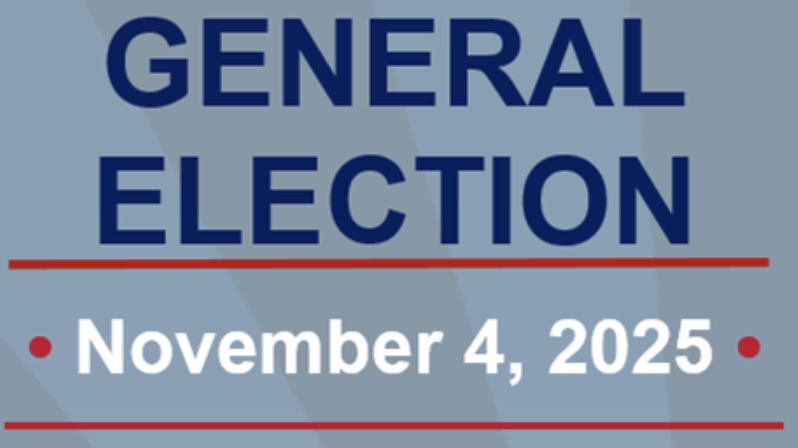Thought of the Week:
I’ve begun to receive a few questions about what next month’s off-year elections may portend for the 2026 mid-term elections. While the upcoming elections in New Jersey, New York, and Virginia will all be interesting, it’s important to remember that the mid-terms are still more than a year away, which is a lifetime for any federal election campaign. What’s more, each of this year’s elections includes its own unique set of circumstances from the candidates running to the local public policy issues involved. What I’ll be tracking are any indications about which way self-described “independent” voters are trending as these so-called “swing voters” often determine election outcomes. A recent CNN survey estimates that 44% of Americans call themselves Independents, while just 28% identify as Republicans and 27% as Democrats. According to the American Enterprise Institute (AEI), this data goes a long way in explaining how the “independent” label is no longer a one-size-fits-all political signifier and leaves open many questions about what such a voter believes. In past election cycles, the Republican and Democrat labels represented a wider set of views much like today’s independent label. What’s changed? The Republican and Democratic parties have fallen into what is termed institutional isomorphism—the process by which seemingly different organizations become like one another. Institutional isomorphism explains why organizations in the same field often become similar in structure and practices over time due to coercive (formal mandates), mimetic (imitating the success of others), and normative (professionalization and shared expertise) pressures. The process results in organizational homogeneity, as organizations adopt similar practices to gain legitimacy and conform to field-level rules. Today, the institutions associated with the right, from conservative media outlets to advocacy groups, have become predominately aligned with President Trump; the litmus test being full White House support. Likewise, for the Democratic Party and institutions on the left, the test is absolute resistance. Any voter who falls somewhere in between is either pressured to conform to the rest of their party or identify as an independent. However, the graph below outlines just how very different “independent” voters truly are. While primary voters, party donors, and ideological media have narrow and concentrated demands any candidate must follow in order to advance to the general election, the result becomes a general election with voters stuck having to pick the least objectionable candidate, chosen by a process that discourages deviation from intraparty consensus. This dynamic doesn’t show any signs of ending anytime soon. We may be on the road to a future where nearly everyone calls themselves an Independent—regardless of what they mean by that. Read more here.

Thought Leadership from our Consultants, Think Tanks, and Trade Associations
Bloomberg Government Expects Chaos if Billions in Tariffs are Ruled Illegal. President Trump has warned of disaster if the Supreme Court overturns his signature tariffs. For starters, it would unleash a bureaucratic nightmare involving reams of refund paper checks. Should the Trump administration’s country-based tariffs be deemed illegal, the U.S. could owe the bulk of the $165 billion in customs duties collected this fiscal year back to companies that paid them. However, firms won’t have an easy time getting their money back; refunds are typically issued slowly with paper checks, and while the White House could streamline the process to repay the funds, experts say that’s unlikely. In fact, President Trump has coveted the revenue from tariffs, saying they have made the country “very rich again.” The president and his allies have floated using the money to carry out policy objectives, including paying down the national debt, funding aid for farmers, and even cutting rebate checks for Americans. This all means the president won’t part with the funds easily if the tariffs are struck down, and the administration is expected to move quickly to reimpose levies using other legal authorities even if that were to happen. The Supreme Court is expected to hear arguments in the case in November.
Eurasia Group Previews Japan’s Policy Outlook Under Takaichi. Sanae Takaichi’s election as Liberal Democratic Party (LDP) president signals a rightward shift within the LDP; her win was rooted in strong rank-and-file support, a response to pressure from the party’s right flank. On economic and domestic policy, Takaichi’s win signals slower monetary normalization but not a change in direction, continued fiscal expansion, and targeted support for industries linked to economic security; her leadership will also support conservative social policies, including restrictions on immigration. On foreign policy, Takaichi will keep Japan on course to boost defense spending, maintain unwavering support for the U.S. alliance, and project hawkishness toward China while seeking to maintain good economic relations with Beijing.
Inside EPA Says Lengthy Shutdown Could Slow EPA’s Deregulatory Agenda. A prolonged shutdown requiring the EPA to furlough employees could throw the agency off its accelerated deregulatory timelines. However, a short shutdown would likely have minimal impacts on the pace of deregulation. If the administration is forced to furlough a majority of the agency there will be an impact in meeting the timelines they’ve set for themselves, say EPA policy advisors. However, because staff are working on tight timelines, the White House is trying to keep employees working on the deregulatory agenda during the shutdown. For now, the administration is using “carryover” funds to keep all EPA employees paid and working for the first days of the shutdown. Unofficial estimates for when those funds will run out, and the EPA will have to furlough employees, range from three days to two weeks. The EPA has struggled to get back on track after prior shutdowns. For example, the 2018-2019 shutdown during the first Trump administration threw regulatory dockets and environmental litigation into chaos by disrupting comment periods and delaying publication of rulemaking documents. By the third week of that shutdown, industry figures warned that it was hindering EPA’s rulemakings and ability to process permit applications, among other functions. Trump administration officials are already signaling that will not be the case this time around.
“Inside Baseball”
USMCA Negotiations Unlikely to Result in New Trilateral Deal. Eurasia Group analysts have updated their scenarios for the United States-Mexico-Canada Agreement (USMCA) review process, with the probability of a “Zombie USMCA” base case rising to 65% (from 45%); a “USMCA-lite” scenario, in which the countries reach a modest deal that maintains some level of U.S. tariffs, stands at 30%; and a “USMCA no more” scenario leading to fully separate bilateral negotiations remains least likely at 5%. The current status quo is favorable for the U.S., and, although economically damaging, remains manageable in the short run for Canada and Mexico—President Trump is able to sustain a high-pressure approach against both trade partners, wielding sectoral tariffs as leverage across a wide range of issues, while Canadian Prime Minister Carney and Mexican President Sheinbaum can tout the world’s lowest average effective U.S. tariff rates. In all scenarios, the U.S. is likely to maintain preferential tariff treatment for Canada and Mexico relative to the rest of the world, although tariffs and trade uncertainty will be features of the North American economy for the remainder of Trump’s presidency.
In Other Words
“I’ve never heard of him. I don’t know who he is,” President Trump on Super Bowl halftime performer Bad Bunny.
“Get out of my f___ing shot! …You also were in my shot before that! …Stay out of my shot!” Katie Porter, current Democratic frontrunner for California Governor, berating a staff member who wanders into the background of a video to correct something she said on-camera.
“Three people, two bullets. Gilbert, Hitler, and Pol Pot. Gilbert gets two bullets to the head. Spoiler: put Gilbert in the crew with the two worst people you know and he receives both bullets every time,” Virginia Democratic Attorney General candidate Jay Jones griping about Virginia Speaker of the House Gilbert.
Did You Know
James Comey is the first former FBI chief to be arraigned since President Richard Nixon’s Watergate fall guy L. Patrick Gray in 1978 (the charges against Gray were eventually dropped).
Graphs of the Week
President Trump’s Steady Approval Rating Starting to Wobble. President Trump’s approval rating among registered and likely voters has been below 45% since the end of September, its longest period since late April through early May. The drop is even more pronounced among all U.S. adults, where his rating dropped to a second-term low of 40.7%. Given the high degree of polarization in U.S. politics, this approval level is likely near the president’s floor. While the drop should not be overstated—and, indeed, President Trump is considerably more popular than he was at the same point in his first term—it does indicate that a confluence of downside risks may weigh on the White House’s political capital moving forward.

